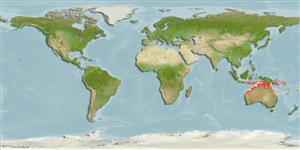Common names from other countries
>
Carangiformes (Jacks) >
Carangidae (Jacks and pompanos) > Caranginae
Etymology: Caranx: French, carangue, the name of a Caribbean fish; 1836 (Ref. 45335).
More on authors: Alleyne & Macleay.
Environment: milieu / climate zone / depth range / distribution range
Ecologia
marinhas; estuarina associadas(os) a recifes; intervalo de profundidade 7 - 63 m. Tropical; 7°S - 23°S
Southwest Pacific: Arafura Sea (Ref. 9819), northern Australia, from the Timor Sea in the west (Ref. 6905) to the Gulf of Papua in the north (Ref. 6906) and on the eastern coast of Australia as far south as Gladstone (Ref. 6907).
Length at first maturity / Tamanho / Peso / Idade
Maturity: Lm ?, range 11 - ? cm
Max length : 66.0 cm TL macho/indeterminado; (Ref. 2334)
Adults are common in prawn trawling grounds and are most abundant closer to the coast. They feed predominantly on benthic prey consisting mainly of crustaceans and teleosts (Ref. 6908). They exhibit diel vertical migration, possibly following the movement of crustaceans along the water column. Continuous spawning during the year (Ref. 6904). Juveniles are often encountered in estuaries. Caught mainly on hook-and-line and by spearing; also with gill nets and other artisanal gear. This species is an excellent sports fish (Ref. 9894).
Randall, J.E., G.R. Allen and R.C. Steene, 1990. Fishes of the Great Barrier Reef and Coral Sea. University of Hawaii Press, Honolulu, Hawaii. 506 p. (Ref. 2334)
Categoria na Lista Vermelha da IUCN (Ref. 130435)
CITES (Ref. 128078)
Not Evaluated
Ameaça para o homem
Harmless
Utilização humana
Pescarias: pouco comercial; peixe desportivo: sim
Ferramentas
Relatórios especiais
Descarregue XML
Fontes da internet
Estimates based on models
Preferred temperature (Ref.
115969): 26.2 - 28.6, mean 27.7 (based on 326 cells).
Phylogenetic diversity index (Ref.
82804): PD
50 = 0.5000 [Uniqueness, from 0.5 = low to 2.0 = high].
Bayesian length-weight: a=0.02455 (0.01365 - 0.04414), b=2.92 (2.76 - 3.08), in cm Total Length, based on LWR estimates for this species & (Sub)family-body (Ref.
93245).
Nível Trófico (Ref.
69278): 3.8 ±0.0 se; based on diet studies.
Resiliência (Ref.
120179): Médio, tempo mínimo de duplicação da população 1,4 - 4,4 anos (K=0.30; Fec: >8,000).
Fishing Vulnerability (Ref.
59153): Moderate vulnerability (36 of 100).
